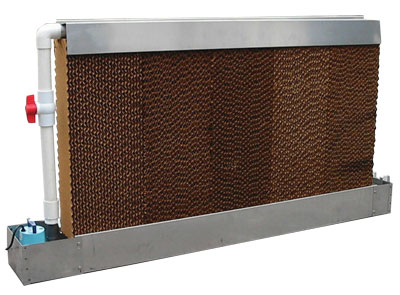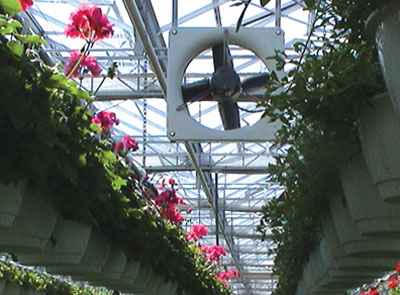Keep Your Cool In The Greenhouse
There is no shortage of options when it comes to keeping your greenhouse cool. From fans to misting systems, growers can protect plants and people from overheating in the houses. Here’s what product manufacturers had to say about their best products and the future of greenhouse cooling.

Big Ass Fans are built to last and come with features that can function in moist environments.
Big Ass Fans Maintain An Optimal Environment For Healthy Plants
Some days, all growers need is a big ass fan. Literally. If that’s the case, Big Ass Fan (BAF) research engineer Thomas Lesser suggests the Essence, the Haiku 84 or the PowerFoil x2.0.
“These fans come with features that can function in moist environments and last a long time,” he says. “The Haiku 84 and the Essence are perfect for greenhouses and indoor growing operations. The Powerfoil x2.0 is our largest, industrial fan, which is also perfect for indoor growing operations, as well as distribution centers.”
One of BAF’s success stories includes Bell Nursery, which installed the Powerfoil x2.0 in its distribution centers where plants might sit for a couple days prior to shipment. The lack of sunlight and presence of moisture cultivates a breeding ground for disease, but after installing the fan, the nursery reported seeing immediate results in the health of its ornamental crops.
While installing a fan seems like an easy solution, picking the right one can be difficult: too much air means structurally weak plants; not enough means ineffective moisture control and standing water reduction.
“We always try to imagine a way to provide adequate air movement throughout these spaces and innovate,” Lesser says. “Energy efficiency is a trend with fans because the amount of energy they have the capability to consume is enormous. Maintaining an optimal environment, however, is important.”
In addition to pursuing greener exhaust fan options, Lesser says he foresees greater connectivity between the grower and the fan. New products will allow employees to control the fan systems remotely, and these cooling systems will work together with irrigation and lighting systems to provide ideal growing conditions.

Quietaire’s evaporative cooling system is stainless steel for corrosion resistance and self contained, meaning no sump is required.
No Sump Needed For Quietaire Evaporative Cooling System
For growers to regulate the heat with a full cooling system, Quietaire has options.
“Quietaire’s evaporative cooling system is made of stainless steel and is self-contained, meaning no sump is required,” says Vice President Darrell D. Dolson III. “We also offer our Quietcool brand portable evaporative cooler for use in production areas and to keep workers cool. Growers tend to gravitate toward our all-stainless-steel cooling system because it does not require customers to have a sump for the water, as opposed to a regular aluminum system with a sump.”
Dramm’s Misting And Cooling Systems Keep The Air In The Greenhouse Cool
Misting systems are another great evaporative cooling option. Dramm specializes in systems that take the heat out of the air by misting fine, 80-micron droplets out of nozzles that allow the water to evaporate before it hits the ground or plants. The company also recommends using the product a certain way to improve results.
“Our approach to operating the system is a somewhat different,” says Kurt Becker, director of commercial products sales and marketing. “We recommend shorter mist times more frequently because it’s less likely to result in wetness under the nozzle. As the temperature rises, you add more cooling but not more time.”

Dramm’s 350mm HAF Fan has an aerodynamic design and high-efficiency motor to maximize the air flow potential of any situation.
For example, a grower might set the JetFog system to start misting at 80 degrees and spray for three seconds every two minutes. At 90 degrees, the interval might be three seconds of mist every minute. All of this means cool air without growing damp, disease-prone plants.
Similar to the trends impacting fans, Dolson and Becker agree that energy efficiency and integrated technology are top of mind. Quietaire is working on alternative energy motor options, and Dramm has become increasingly interested in the grower’s ability to manage the equipment using automated control systems.
“We expect to see an increase in the level of control and how sophisticated the systems can get,” Becker says. “Our company doesn’t do that, but we work with other manufacturers to create these controls.”
Automated Monitors And Controls From Onset Save On Labor
When it comes to increasing control, monitoring products can do everything from log important data on a computer to sending text alerts to employees. This is particularly important for ensuring the greenhouse temperature is just right every time. One such system is Onset’s new HOBO RX3000 remote monitoring system.
“This relay control system allows growers to turn heating and cooling equipment on and off based on its readings,” says product marketing manager Paul Gannett. “This remote monitoring system is also web enabled, so you can monitor the systems remotely.”
If the monitoring system notes a problem, greenhouse managers are only a text away, even on the weekends. Growers also benefit from reduced labor costs because workers don’t have to be constantly checking the thermostat, adjusting the ventilation systems and messing with the equipment settings. Although this wireless system is impressive, Gannett predicts it is just the beginning.
“I see even more integration of monitoring and control capabilities including with scheduling systems,” he says.
“Growers are asking for things that are wireless, mobile friendly and offer better diagnostics so that problems can be fixed in less time. Once everything becomes web-enabled, it will be a straightforward process. Everyone is busier nowadays, so the systems need to be seamless.”









